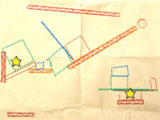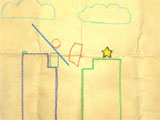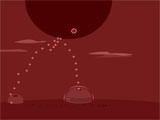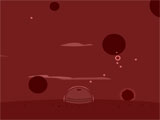Defend Your Monochromatic Turret in Red
Red is a wonderfully simple game using realistic physics to take the Missile Command concept to a new level with a greater suspension of disbelief and emotional intensity. You can find Red floating around any number of flash gaming sites, but it is oddly missing from Armor Games (the game’s credited source).
Simple Concept Goes a Long Way
I really appreciate the simplicity of Red because its physics inherently produce room for strategic thought. The player uses the mouse to blast small balls from a round turret at much larger balls hurtling downward from the sky. Each interaction between your “bullets” and the slowly approaching “meteors” applies realistic physics, bouncing the bullets out in different directions and pushing the oncoming meteors up and away. Just selecting the part of a meteor to shoot is a challenge when you only have a fraction of a second. Also, the chaotic spray of bouncing bullets can be used to your advantage when they bounce off of one target and into another. This suggests an interesting multi-tasking element when you must blast 2 or 3 meteors at the same time, but the concept is mostly unexplored.
Massive Impact
After 30 seconds or so, power-ups will show up, allowing you to obtain a force field, supporting turrets or (my personal favorite) extra heavy bullets that pound the sky clean and ricochet into the ground, leaving dark, gaping holes. Those slugs really demonstrate the effect physics can have on a game experience. Each physical interaction lets you know you’re not just hurling a bunch of pixels, you’re packing mass! This is what separates Red from a non-physics game like Missile command.
Unexercised Variety
Occasionally, a particularly gargantuan ball will arise, marking the end of a phase and the beginning of a greater difficulty level. Just as one would expect, higher levels mean more and faster balls to shoot, but they’re also the harbingers of new wind-speeds. Changing wind effects keep things dicey, forcing you to compensate for the curvature of your bullets’ trajectories. Unfortunately, that’s when the game’s variety peters out, which is disappointing because a great deal of even simple possibilities were ignored (like meteors with less predictable trajectories, a moving turret or zooming out to shoot at longer ranges). After a few minutes of play you’ve seen all that’s worth seeing and you’re probably just hoping you’ll die an honorable death at the hands of a meteor instead of exiting the game like a coward. That’s a place I never like to be.
10% of a Great Game
Overall I found Red to be a really fantastic basis for a game, but it feels more like a demo than a full experience. Click the “About” button and the mysterious creator, ” Case,” suggests Red is the beginning of a series of chromatically named games. Orange was the only one I could find available and I wasn’t impressed.
Red is free so give it a go, but don’t expect to be entertained for longer than a few minutes. Let’s hope our friend Case has some new concepts up his sleeve for the next project. He demonstrates an excellent use of the mouse interface and basic physics to produce an intuitive and entertaining game.
Play Red Online (Flash required)
Related Posts:
- No related posts
Both Waxy and Delicious: Crayon Physics
Petri Purho’s Crayon Physics, like the previously-reviewed Pluto Strikes Back, was created as part of his ongoing Kloonigames experimental game project. Purho tries to put out a new game each month, allowing himself no more than seven days to create each. Crayon Physics was done in five. As a bare-bones prototype, it doesn’t quite have the depth of a finished title. It compensates for a lack of polish with a layer of kindergarten charm and a loop of soothing licensed music. As a proof of concept, the game plays fine.
So what’s the concept?
Drawing Physical Objects
Each of the game’s drawing paper screens contains one or more bouncing yellow stars and a small ball of red crayon wax. The puzzle is solved when the ball has touched each of the stars. Obstacles and contraptions – walls, see-saws, bottomless pits – are sketched onto the path in bright, primary crayon colors. But the player can draw too.
Anything the player scrawls with the mouse on the drawing paper screen is instantly imbued with weight and volume. Draw a box in the sky and it plummets to the ground. Draw one over a see-saw, and it sends what’s on the other end into the air. A well-placed block will flip the ball over the see-saw and to its destination. Solve physical problems by drawing objects into existence: that’s the premise of Purho’s prototype.
You Can Draw Anything You Want, as Long as it’s Square
Unfortunately, Purho’s five-day coding exercise just isn’t as robust as my imagination. Though I’m given this big canvas to draw on, I’m only allowed to sketch squares. Anything I draw, no matter what it looks like, will have the properties of a rectangle when brought to life by the game. A drawing that’s too far off the mark will simply be transformed into a perfect rectangle. It’s often unclear exactly what the dimensions of a new object will be, especially when trying to draw something long and thin.
The game would be much more interesting if it allowed me to draw a round ball and a slope to roll it down, but curves are beyond the game’s shape recognition. And while I can play with see-saws the game provides, sketching my own is out of the question. The ball just doesn’t have enough vertical motion – it doesn’t bounce – to do anything but bump the side of anything I draw. Interacting with the ball usually comes down to dropping a box on it and hoping it rolls in the right direction. It just seems like a sloppy and imprecise way of interacting with the world, especially considering my ability to draw right on the screen.


(Crayon Physics Game Screenshots)
Crayon Basics
Crayon Physics is a very limited game, despite a premise that calls to mind lots of possibilities. That’s because it was built as a prototype. It’s the most basic implementation of a drawing-based physics game, created to demonstrate how the concept might work. And what’s there does work – it’s playable from start to finish, if a little elementary. It’s also free and won’t take longer than fifteen minutes to play through. For anyone curious about what a game that combines physics with player-created shapes might look like, it’s time worth investing.
Download Crayon Physics (5.63 MB)
Visit Petri’s Kloonigames blog for more great experimental games.
Related Posts:
Switchball Released
Switchball, the physics-based marble platform game, has been commercially released! A trial version of the game is available from the official site, and the full version is available for $19.99. I previously reviewed the old one-level demo of the game. Look for an updated review soon!
In other news, fresh reviews will start being posted this Wednesday on a regular schedule.



 (Rate this game! 76 votes, average: 3.70 out of 5)
(Rate this game! 76 votes, average: 3.70 out of 5)

 My name is Matthew Wegner, and this site is dedicated to physics games.
My name is Matthew Wegner, and this site is dedicated to physics games.